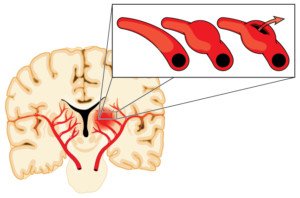Can your “jabs and jolts” stabbing head pain be caused by an aneurysm that’s about to rupture?
Aneurysm pain from rupture is classically a “thunderclap” headache: sudden in onset, and excruciating, the worst head pain ever.
But what about those very painful jolts or stabs of head pain that may last for only one second?
These attacks of very brief but sharp head pains may occur a few times a year to dozens of times in a single day, says a study by Pareja et al (journal Cephalalgia).
What makes a person terrified of a rupturing aneurysm is when these stabs of only a few seconds are local — at a specific location about the head.
The randomness of these brief stabs also makes the patient think that a leaking or rupturing aneurysm is even more likely.
The “jolts and stabs” phenomenon can also occur at different locations about the head.
This condition goes by the names idiopathic stabbing headache and ice-pick headache.
Idiopathic means no known cause. They are not connected to aneurysms.
The study states that the very brief, piercing head pain of idiopathic stabbing headache is a “primary benign” condition.
Slowly Leaking Aneurysm
There’s a difference between a rupture that spurts blood into the brain and a tiny-enough tear in which blood slowly leaks out.
However, a slow leak will typically cause the worst headache you’ve ever had.

©Lorra Garrick
This alarming headache is a warning that in the next few days to weeks, the aneurysm will full-out rupture.
Head pain from an aneurysm can also be caused when the bulge pushes on nearby structures.
Depending on location of the slowly leaking bulge, you may not have a headache but instead have any of the following:
• Vision loss
• Double vision
• Eye pain
• Neck pain
• Stiff neck
• Ear ringing
Symptoms of a Ruptured Aneurysm May Include:
• Thunderclap headache
• Stupor or unconsciousness
• Ptosis (drooping eyelid)
• Visual disturbance
• Muscle weakness
• Numbness
• Seizures
• Difficulty speaking
• Stiff neck (rare)
A headache that’s associated with a leaking aneurysm will be ongoing, rather than last only a second or a few seconds.

Schematic of a ruptured aneurysm. Shutterstock/Blamb
Blood that’s spilling or leaking onto the brain does not magically vanish, then reappear for two seconds, then vanish, then reappear for two seconds, and so on.
It’s either there or is not. When it’s there, the headache will be continuous.
Aneurysms under half an inch in diameter with no leaking whatsoever typically do not cause symptoms and are usually discovered by accident when the brain is imaged for an unrelated reason.
Larger aneurysms without any leaking can cause neurological symptoms including dilated pupils, weakness and numbness, a localized headache and pain behind an eye.
Idiopathic stabbing headache, by definition, is not caused by an aneurysm.



























